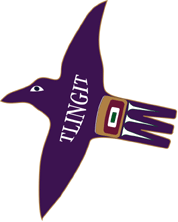 Tlingit Indians of Southeastern Alaska Tlingit Indians of Southeastern Alaska
Section 1: TLINGIT COUNTRY 7 days (2 weeks). CONCEPTS: ADAPTATIONS,
ENVIRONMENT OF SOUTHEASTERN ALASKA, TLINGITS BELONG TO CLANS OBJECTIVES
-
Students exhibit a knowledge of the
components and some of the resources of Southeastern Alaska's environment.
-
Students can name and locate the three
Indian groups in Southeastern Alaska: the Tlingits, Haidas, and Tsimshians.
-
Students learn that Tlingit society
is divided in clans and that clans have crests.
| MATERIALS
- Native Peoples
and Languages of Alaska
map
- Books or pictures for bulletin boards
- UN 642 or F 3665 (Enrichment)
- UN 639, Northwest Coast Study Prints if available
- Northwest Coast Indian Art (Alaska State Museum
mini-kit)
- Art supplies for student folders
- Community Profiles
- Worksheet 1 and 2
(in pdf)
- Glossary
(in pdf)
- Tongass National Forest map
- Posters: Harvest Time at the Beach, Living by the
Seasons, Environments of Lingit Aanee
- VT 735 (Enrichment)
- Tlingit Trade Game
- Student text, The Tlingit
World
|
PREPARATION
- Order any AV materials you want to use during
the course of this unit
- Schedule museum visit for six weeks from now (see
Section 5)
- Tack up Language map
and Tongass National Forest map
- Order UN 639, Northwest Coast Study Prints
from AVS Center if your school does not own the prints.
- Make a bulletin board showing the art of Southeastern
Alaska
- Make copies of Worksheets
1 and 2 (pp. 53, 55 & 56).
- Make copies of Glossary (pp.
59 & 60).
- Laminate Environments of Lingit
Aanee poster if this has not been done
- Obtain new stickers for Environment poster if necessary
(see p. 13)
|
ACTIVITIES
| DAY 1 |
- Review concepts of environment and adaptation
- Groupwork: predictions about environment based on study
of art
- Map study: Language map,
Worksheet 1
|
| DAY 2 |
- Natural Resources Center: Posters, Sticker, and Worksheet
2 LANGUAGE ARTS: Raven stories
|
| DAY 3 |
- Assign clans, decorate folders for this unit
|
| DAYS 4 & 5 |
- Chapter 1 in The Tlingit World
- Enrichment: Locate clans in their home villages
- Introduction to Tlingit Trade Game
- Read Chapter 2 in The Tlingit
World.
|
| DAY 6 |
- Review for Quiz.
|
| DAY 7 |
- Quiz
|
|
NEW VOCABULARY
Tlingit
Tsimshian
Haida
Northwest Coast
Southeastern Alaska
clan
crest
commodity
|
From the Reading
Lingit Aanee
evidence
bladder
populated
eulachon
crocheted
middlemen
|
(The following list
contains names of 14 of the approximately 50 Tlingit clans and need not be
memorized by your students):
Chookaneidee
Dakl'aweidee
Deisheetaan
Gaanax.adee
Kaach.adee
Kaagwaantaan
Kiksadi
Kwashk'i kwaan
Naanyaa.aayee
Shangukeidee
T'akdeitaan
Teey hittaan
Teiweidee
Wooshketaan
A NOTE ON THE STUDY OF TLINGIT CULTURE, LANGUAGE ARTS, AND ART
You will notice a large number of green pages interspersed
throughout this guide. These pages denote activities in disciplines other than
social studies, either language arts or art. (Web-converter's
note: this resource was a photocopy, so it is not formatted like the original)
Tlingit culture is a natural choice for an interdisciplinary
approach: the art is probably the richest of all Native American traditions,
and the literature is rich, complex, and fun.
It is thus strongly recommended that, during your
study of Tlingit culture, you plan to devote part of your language arts and
art time to activities about or from that culture. See the green pages in this
guide for ideas.
Section 1: TLINGIT COUNTRY CONCEPT: ENVIRONMENT
OF SOUTHEASTERN ALASKA
PREPARATION FOR UNIT: MUSEUM VISIT
At this time you should schedule your class's museum visit through
the Community Resources office (276-8011). It should occur during the 4th, 5th,
or 6th week of your study of this unit. Be sure to tell the office that you
are studying the 4th grade Tlingit social studies unit, since a special tour
has been planned. Indicate whether you want the tour to cover both Athabascan
and Tlingit areas or just Tlingit. PREPARATION
FOR UNIT: BULLETIN BOARD Set the mood in your classroom by tacking up the Native
Peoples and Languages of Alaska map, the Tongass National Forest map,
and by preparing a bulletin board or table top center with books, photographs,
or pictures of artwork from the Southeastern portion of the state (Northwest
Coast art). Sources for art pictures include Northwest Coast Indian Art
(Alaska State Museum mini-kit, in your library), UN 639, Northwest Coast
Study Prints (more than half the schools own their own sets and need not
order the unit; see Appendix G for a listing of the schools), UN 642, (Far North
Unit), magazines such as National Geographic, Alaska Magazine, or Alaska
Journal. For a listing of books which contain pictures, refer to Appendix
E at the end of this guide. DISTRIBUTE PAPER FOR FOLDERS Students will need a place to put worksheets on the first day.
However, they will not decorate their folders until the third day.
Section 1: Tlingit Country DAY l
CONCEPTS: ADAPTATIONS AND ENVIRONMENT
Begin instruction with a review of the concepts of environment
and adaptations, both covered in detail during the Athabascan Social Studies
unit. Review some of the adaptations to the environment which the Athabascans
exhibited. SMALL GROUP WORK OR CLASS DISCUSSION: NORTHWEST COAST STUDY PRINTS and NORTHWEST COAST INDIAN ART MINI-KIT The following discussion/activity can be carried out with either
small groups (4 students each) or with the class as a whole. If you are using
small groups, divide the students up. Tell students that you expect all to participate
in the small group discussions, and that all students must be able to participate
in the class discussion to follow. Then refer to the Northwest Coast Study Prints
and photographs in the Northwest Coast Indian Art mini-kit and explain: "These items are all from another part of Alaska. Look at
them closely and try to describe what type of environment they are adapted to
and came from. Give reasons for your answers. You will have 5 minutes to come
to a conclusion." You might review with them the clues they will use in
deciding the objects' home environment (for instance, "What are the items
made of? What clues does that give about the environment?"). After 5 minutes, reassemble the class for group reports. As groups
describe the environment from which the objects probably arose, review the factors
that led them to those conclusions: for example, what materials were used in
making the objects? What might the objects have helped the people from the area
do? What kinds of plants and animals were probably available to the people who
made these objects? Etc.
LANGUAGE MAP, WORKSHEET 1
Now turn to the Language Map. Review
the Athabascan area's location. Point out the Southeastern portion of the state
and identify
the Tlingits, Haidas,
and Tsimshians. Explain why this is called "Southeastern Alaska." Then
explain that the art objects students have been viewing were made by members
of the three groups in Southeastern Alaska. Tell the students
that they will be studying the Tlingit people, who are the largest group
of Alaska Natives in Southeastern
Alaska. Explain
that the word "Tlingit", sometimes spelled "Lingit", means
"the people" in the Tlingit language.
Distribute Worksheet 1
at this time and have students fill it in and, if you like, color it.
ENRICHMENT: LINGIT
AANEE Read Lingit Aanee to your students to give
them a feeling for the environment in Southeastern Alaska. Explain to the
students that "Lingit"
is the correct spelling of "Tlingit" and that "Aanee" means
"the home or place". As with the Athabascans, the Tlingits had to obtain their necessities
from the natural environment. From the information described in this booklet,
elicit two lists from the students (example follows):
1. Possibilities for survival afforded
by the environment 2. Limitations which the environment
poses. Compare the two lists. Have students copy them and place them
in their folders. Refer to them later when you discover how the Tlingits actually
did use their environment. SAMPLE LIST Lingit Aanee
|
| Possibilities |
Limitations |
|
|
water travel
wood tools, houses
beach and ocean food
berries
fur clothing
|
Land travel difficult
hard to grow crops
need protection from rain
sometimes limited visibility
|
DAY 2
NATURAL RESOURCES OF LINGIT AANEE CENTER:
HARVEST TIME AT THE BEACH POSTER, LIVING BY THE SEASONS POSTER, ENVIRONMENTS
OF LINGIT AANEE POSTER, RESOURCES STICKERS, COMMUNITY PROFILES, WORKSHEET 2
Additional materials for this center might be pictures of the resources or environment
of Southeastern Alaska, obtained from National Geographic, Alaska
Geographic, Alaska Magazine, Alaska Department of Fish and Game,
U.S. Fish and Wildlife, and travel folders.
Direct the class to look at and decipher the Harvest Time and Living
by the Seasons posters. Then point out that all the resources shown on those
two posters have been reproduced as stickers. The students' task will be to
place those stickers in the proper part of the Environments
of Lingit Aanee poster. (Be sure to laminate the poster first so it
may be used year after year. You will need to obtain replacements for the stickers
each year.)
There are 53 stickers (some resources are duplicated if they are normally found
in more than one environmental zone) so most students will be able to place
two stickers on the poster. Information on the correct environmental zone is
listed on the stickers.
When all stickers have been placed, students should complete either page 1 or
page 2 of Worksheet 2. When all have finished,
talk about the worksheet. Make a bar graph on a piece of butcher paper to show
the numbers of resources in each environment (see example, p. 15 following).
Discuss which zones contain the most resources. Tell students that the Tlingits
built their houses along the beach. Did this make sense, considering the availability
of resources in the various zones? FILM (ENRICHMENT) Tlingit Ani (another spelling for Lingit Aanee), F 3665,
is a good film for depiction of the environment of Southeastern Alaska. WRITING (ENRICHMENT) Ask students to write paragraphs or stories beginning with:
"I woke up and jumped out of bed. I ran outside
to look around. Our family had just flown to Southeast Alaska last night,
and
I wanted to see what it looked like. When I looked around me I saw...
I smelled . .
I felt . . ."
Number of Resources in Environments of Lingit
Aanee (in pdf format)
Section 1: Tlingit Country
LANGUAGE ARTS
LANGUAGE ARTS: RAVEN STORIES
During Read to Kids time in your classroom, read
one or more of the Raven stories (Appendix H, pp.
185-244) which tell about the formation of the Tlingit world. You might refer
to the stories as you talk about the land and its resources during the next
few days.
See also VT 735 (1982 Festival of Native Arts)
for Tlingit storyteller Walter Babe Williams' rendition of "The First Tlingit".
DAY 3
CONCEPT: TLINGITS BELONG TO CLANS
ASSIGN CLANS
Explain to students that Tlingit society is divided
into about 50 clans, and that everyone is a member of a clan. Explain that
a clan is a large family, including cousins, aunts, uncles, grandparents,
nieces, nephews. Explain further that each clan has several crests, or designs,
which identify it. Liken these to Scottish clan tartans, heraldic emblems,
or national flags. Finally, tell students that in Tlingit society, the clans
are divided into two groups. About half of them are Raven clans, and the other
half are Wolf (Eagle in the north) clans. Now tell students that your class
will be divided into clans, clans which they will keep throughout the unit.
There should be five or six clans in your room. You may work this in one of
two ways:
First, if more than one 4th grade class
is studying the Tlingit unit at this time, you could divide one class into
several Raven clans, and the other into Eagle clans. This arrangement is
helpful
in demonstrating the concept of "moiety", since one class is one
moiety and the other class is of the other moiety. A potlatch can be held
with one class being the hosts, the other the guests, and mock marriage partners
can be chosen, one from each class. Directions for these activities appear
later in this guide.
Alternatively, your own class can have in
it representatives of both the Raven and the Eagle moieties. Make sure that
you have at least two clans to represent each moiety. If you have Tlingit
students in your class, ask them their clans or, if they don't know, ask them
to find out. They should be placed in their own clan group.
A partial list of clan names and the main crest symbol
for each follows (but note: each clan has more than one crest symbol). See
the Glossary (p. 59 & 60) for pronunciation
aids. Pictures of some of the actual crest designs follow.
|
RAVEN MOIETY
Gaanax.adee
(or Gaanaxteidee): Woodworm
Deisheetaan: Beaver
Kiksadi: Frog
T'akdeintaan: Seagull
Kwaashk'ikwaan: Humpback salmon
Kaach.adee: Raven
Teey hittaan: Winter Raven
Additional Raven crest symbols include:
Coho, goose, snail
|
EAGLE MOIETY
Naanyaa.aayee: Eagle, Shark
Kaagwaantaan: Brown bear
Shangukeidee: Thunderbird
Chookaneidee: Halibut
Teikweidee: Golden Eagle
Wooshketaan: Wolf
Dakl'aweidee: Killerwhale
Additional Eagle crest symbols include:
Eagle, porpoise, iceberg, petrel, murrelet
|
DECORATE FOLDERS
Now have the students decorate their folders with
their clan name and crest design as well as their personal names.
Section 2
HANDOUTS (in
pdf)
DRAWINGS OF TLINGIT CREST DESIGNS
by Jim Marks
Courtesy of the
Juneau Indian Education Act Program
DAYS 4 & 5
CONCEPT: HOW PEOPLE CAME TO LINGIT
AANEE
CHAPTER 1 IN THE TLINGIT WORLD
Read and discuss Chapter 1 in The Tlingit World.
Note that some of the Raven stories can be found in Appendix
H of this guide.
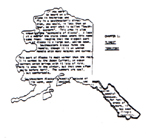
Click on image to see a bigger one
The Tlingit people are known around the
world for their beautiful artwork and for their wealth. They lived in a place
with rich food resources, and they learned how to harvest them.
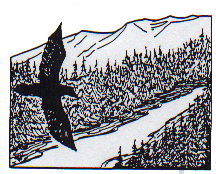
The Tlingit people have not always live in Southeastern
Alaska. They originally came from the interior parts of Canada.
How do we know that the Tlingits moved to
the coast from somewhere else?
We have two types of evidence:
FIRST, are Tlingits legends. According to
old stories, Raven, the creator of the world and of the Tlingit people, came
from the Mass River. This is in Canada and is now Tsimshian territory, but it
must once have been the name of the Tlingits.
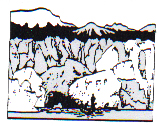
Other old stories tell of the Tlingits
first arriving at the coast. The people traveled together by clans, or large
families.
Each clan came separately, and each clan has its own migration story. Many
of the clans tell of their people coming from the interior. Some were once
related
to Athabascan people -- cooled in the Tlingits call "Gunnaa" (spelling?).
In many of the stories, the people left their homes because of some problems
there, either wars with others or trouble getting enough food. They came through
the mountain passes, not glaciers, and found a way to travel under the glaciers
to the coast.
One clan that came to southeastern Alaska
that way are the Shangukelders. They remember that, when they first got to the
coast, they did not know that tides rise and fall. As a result, one of the people
got caught by a giant oyster, far out on the beach during low tide. As the tide
came in, he felt the water get higher and higher around his body. Although his
relatives try to help him breathe with the bladder filled with air, he eventually
drowned.
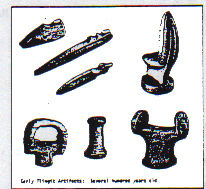
The SECONDS kind of evidence of the Tlingits'
migration is from archeology. Ancient artifacts have been dug up in southeastern
Alaska: the oldest are about 10,000 years old. But these artifacts did not belong
to the ancestors of the Tlingits: they belonged to some other, long-lost people.
The earliest Tlingit artifacts to be found are only a few hundred years old.
The recent date for these artifacts shows that the Tlingits came from somewhere
else, to a place where others have lived before them.
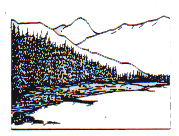
After the clans came to the coast, each
started its own village. Sometimes some of the members of the clan would move
to another place and start another village. And sometimes, a clan would decide
to settle any village which someone helps had already started. In this way,
the whole of southeastern Alaska became populated.
ENRICHMENT: LOCATE CLANS
If you like, you can give another bit of information
to your class clans. Students know their main crest; you can now tell them
which
parts of Lingit Aanee their clans settled. Using the following list and map,
locate each of the clans in their own parts of Southeastern Alaska. The division
lines on the map show the locations of the Tlingit "kwans", which
were geographical regions. Each kwan had one or more villages in it, and
was
settled by more than one clan. Kwans were not political units with chiefs;
those men who were leaders were leaders only of their own clan, not of a certain
territory. You might make clan markers on the Language Map or Tonga.ss National
Forest map.
RAVEN MOIETY:
| Deisheetaan (Beaver): |
Killisnoo (village of Angoon) |
| Gaanax.adee (Woodworm): |
Tongass, Taku, Chilkat (village of Klukwan),
Yakutat |
| Kaach.adee (Raven): |
Kake, Stikine |
| Kiksadi (Frog): |
Tongass, Stikine, Sitka, Sanya |
| Kwaashk'1ikwaan (Humpback salmon): |
Yakutat |
| T'akdeintaan (Seagull): |
Hoonah |
| Teey hittaan (Winter raven): |
Stikine |
EAGLE/WOLF MOIETY:
| Chookaneidee (Halibut): |
Hoonah |
| Dakl'aweidee (Killerwhale): |
Tongass, Killisnoo (village of Angoon), Chilkat (village
of Klukwan) |
| Kaagwaantaan (Brown bear): |
Hoonah, Sitka, Chilkat (village of Klukwan) |
| Naanyaa.aayee(Eagle): |
Stikine |
| Shangukeidee (Thunderbird): |
Henya (village of Klukwan), Kake, Yakutat, Chilkat (village
of Klukwan) |
| Teikweidee (Golden Eagle): |
Tongass, Killisnoo (village of Angoon), Yakutat, Sanya |
| Wooshketaan (Wolf): |
Auke, Killisnoo (village of Angoon), Hoonah
|
Tlingit Kwans in pdf
(Geographical Areas)
CONCEPT: ENVIRONMENT AND GEOGRAPHY OF SOUTHEASTERN
ALASKA
TLINGIT TRADE GAME
Introduce the Tlingit Trade Game to
students at this time and have them play it once. When thee students have mastered
the rules, they can play it during indoor recess, when other work is completed,
or at other times you may assign throughout the course of this unit.
The game itself at first seems harder than it really
is, and the learning students gain from it is worth the time it takes to teach
the rules. They will not learn unless they have a chance to play it a
number of times, however.
At this point in the unit, you are interested in
the students attaining two objectives.
1) Students become familiar with a map of southeastern
Alaska.
2) Students begin to recognize some of the natural
resources (trade items) available to the Tlingits.
A later, important objective, the trade system
itself, will be discussed by you and the students later in the unit (see
pp. 130-133)
EXPLAIN RULES
Explain the purpose of the game to students. There
are five game boards per set. Divide your class into five groups of five or
six. It would be best not to use the clan groups as game groups. Instead, divide
the clans up so that each clan member is playing with members of other clans.
Each group should be given its own trade game and copy of the Tlingit Trade
Game Rules card. Explain the components and rules
of the game to students. Tell students that each player is the representative
of his clan. Then provide time for them to play.
An alternative method of teaching the rules
is to instruct five students at some point on a previous day. Each of the five
then becomes the teacher for a group of students.
CHAPTER 2 in The Tlingit World
Read aloud and discuss Chapter 2 in The Tlingit
World which describes the various commodities which the students encountered
in the Trade Game.
CHAPTER 2: TLINGIT COMMODITIES
When the first Tlingits
settled Southeastern Alaska, they chose their villages according to the resources
they found there. One group, for instance, noticed that the Stikine River had
a heady run of candlefish, or eulachon. The oil from this fish was nutritious
and delicious, and was the necessary part of their diet. This made the mouth
of the Stikine a perfect choice for a village site.
Each village had
many resources near it. In fact, each village has more than enough of some resources,
so it traded those for others which it lacked.
The Tlingit villages
could be divided into two groups. According to the resources they had: the MAINLANDERS
and the ISLANDERS. All of the villages, both mainland and island, were on the
sea and so used these resources most of all. And although villages depended
on salmon as their main food.
But the villages
on the mainland had an added advantage: they were at the malice of rivers which
had, not only a salmon run, but also a eulachon run. These people had a surplus
of the very valuable eulachon oil to trade.

|
|
|
| The villages on the islands head different
commodities to trade. They gathered more sea resources than did the
mainlanders. Instead of eulachon oil, they had a surplus of seal oil
which was valued by other Tlingits. They had clams, mussels, dried
halibut, and sea urchins in large supply. They hunted sea otters for
the warm, soft, and durable fur. The islanders also had wood products
to trade, because yew and cedar trees grew larger on the islands where
the climate was warmer. |
|
|
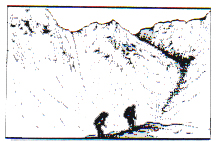
In the days before
becoming of white men to Southeastern Alaska, the Tlingits were master traders.
They traded with Haidas, Tsimshians, and other southern groups. They kept some
of the things they got from them, and took other items farther north to trade
to the Athabascans. They were middlemen, and the made a profit by it. Without
the Tlingits, the northerners and southerners could not get goods from each
other.
The Tlingits knew
that being middlemen was profitable, so they made sure that they, and the alone,
could fill this role. They controlled to trading routes to the Interior. They
would not allow travel over the mountain passes without permission. In this
way, they were able to charge both the southerners and northerners for transportation
of goods.
TLINGIT TRADE GAME
Materials Provided:
1 Teacher's Guide
1 Game board
1 set of game cards consisting of
30 BLUE Tlingit Island Commodity cards
29 GREEN Tlingit Mainland Commodity cards
7 BROWN Copper River Commodity cards
7 LIGHT BLUE Southern Tribes Commodity cards
12 LIGHT GREEN Interior Tribes Commodity cards
12 ORANGE Town cards
9 RED Hazard cards
9 RED Boon cards
YOU NEED TO SUPPLY TOKEN PIECES FOR PLAYERS TO
MOVE AROUND THE BOARD.
COMMODITY CARDS
Each Tlingit Trade Game should have the following
numbers of commodity cards:
GREEN: Mainland Tlingit
5 spruce root baskets
5 rabbit or marmot skin blankets
5 sheep or goat horn spoons
5 chilkat blankets
5 cranberries in oil
2 eulachon oil
2 moosehides |
LIGHT GREEN: Interior
2 moosehides
2 decorated moccasins
3 caribou hides
2 birchwood bow w/porcupine gut string
3 wolf moss for dye |
BLUE: Island Tlingits
2 greenstone for tools
2 dried deer meat
2 yew wood
4 sea otter pelts
5 dried halibut
5 seal oil
5 clams, mussels, & sea urchins
5 cedar bark or wood |
BROWN: Copper River
4 deer meat
1 wolf moss for dye
1 copper
1 caribou hide |
LIGHT BLUE: Southern Tribes
2 eulachon oil
2 dentalium shell
1 iron
1 cedar canoe
1 abalone shell |
|
Background Information: The Commodities
ISLAND TLINGIT COMMODITIES
Six island towns (Henya, Sitka, Hoonah, Angoon, Kake
and Kuiu) have been chosen as home towns for this game. The cormiodities which
are associated with those towns reflect their sea orientation as well as the
slightly more moderate climate of the islands. Thus, the sea otter pelts, dried
halibut, seal oil, and clams, mussels and sea urchins were eagerly sought by
mainland Tlingit villagers and were readily available to the islanders. In addition
to these maritime resources, the islands had an easily accessible source of
greenstone (used in fashioning tools), and the milder climate of the islands
allowed for the growth of more and larger cedar and yew trees than in the mainland
river valleys. Dried deer meat was made available by virtue of the many Sitka
black-tailed deer on the islands, which was one of the few land animals actively
hunted by the island Tlingits.
The importance of most of the above-mentioned commodities
is apparent; however, some were considered especially valuable. Seal oil, for
instance, was in demand by mainland villagers, for it was a commonly used condiment
eaten with most dried foods. Cedar bark and wood were also valuable for use
in carving, weaving baskets and mats, and being entwined with goats' wool to
make the beautiful ceremonial Chilkat blankets produced by mainlanders. Finally,
yew wood was used in making bows, boxes, and dance batons.
MAINLAND TLINGIT COMMODITIES
Six mainland towns (Chilkat, Yakutat, Tongass, Auke,
Chilkoot, Stikine) were chosen as home towns for this game. Most of them were
located in the slightly colder micro-environments along river valleys. Fur-bearing
animals were thus more readily available to mainlanders, as were river products
such as the highly prized eulachon oil. The land orientation of these villages
is apparent in the spruce root baskets (used for a large number of household
tasks), cranberries in oil, sheep or goat horn spoons, rabbit or marmot skin
blankets, moosehide, and ceremonial Chilkat blankets (which were woven from
mountain goat wool and cedar bark). Of these commodities, three deserve additional
mention: the eulachon oil, Chilkat blankets, and sheep or goat horn spoons.
All were extremely valuable because of their rarity and importance in ceremonies
(potlatches).
COPPER RIVER COMMODITIES
Located along a major trade route (the Copper
River), and having access to twb very important commodities, the Copper River
Athabascans
(Ahtnas) and Eyaks were in a good position to trade with the Tlingits. Raw
copper was traded for use as daggers, mask decorations, and the prestigious "coppers"
or "tinnehs" which were the foremost symbol of wealth to a Tlingit
clan. Wolf moss (actually a lichen) was also valuable as the dyestuff used
in
producing yellows in Chilkat blankets.
SOUTHERN TRIBES COMMODITIES
Like the mainland Tlingits, Southern tribes had access
to the valuable eulachon oil rendered from river-run eulachon. The Tsimshians,
occupying the river valleys, were especially wealthy in their eulachon oil supplies.
In addition, it was in the south that huge cedar trees grew, and the Haidas
in particular traded trees large enough to make cedar canoes and totem poles
to the Tlingits. Dentalium shells were obtained from the west coast of Vancouver
Island by the Nootka, and were traded far up the coast. They were important
as decoration on the ceremonial garb of the Tlingits, and were perhaps even
more important as symbols of wealth (though not as actual currency) among the
Athabascans in the interior of Alaska. Abalone shells were also used in decorating
carvings and ceremonial garb. Finally, ironwas available from the southern tribes,
and came originally from the European settlers far to the south.
INTERIOR TRIBES COMMODITIES
The Interior tribes, or Athabascans, desired many
of the commodities available in the more temperate Tlingit environment, but
they also had certain valuable commodities to trade. Both moosehide and caribou
hides were welcomed by Tlingits: moosehide was used in making moccasins and
was also thick enough to serve as a protective shirt in combat, while carjbou
hides made the warmest garments and sleeping robes. Wolf moss, as mentioned
above, was used in making the yellow dye for Chilkat blankets. And two types
of handiwork, decorated moccasins and birchwood bows, were highly prized by
Tlingits for their workmanship and usefulness.
Background Information: The
Towns
Students may notice that the towns in this game do
not correspond exactly with the kwans they just learned. This is because the
kwans sometimes contained more than one town. So, for instance, Chilkoot and
Chilkat were both part of the Chilkat kwan.
Games Rules: 3-
6 players
1. The object of the game is to trade with different
groups so that you have, in the end,
ONE INTERIOR TRIBES CARD
ONE SOUTHERN TRIBES CARD or ONE COPPER RIVER CARD
TWO MAINLAND TLINGIT CARDS
TWO ISLAND TLINGIT CARDS
For a total of six cards.
2. Each player starts with 9 cards, which are either
all Island Tlingit cards or Mainland Tlingit cards. To determine which type
of cards a player starts out with, divide the town cards into two groups, the
.island towns and the mainland towns, as follows:
Mainland towns:
Chilkat
Yakutat
Tongass
Auke
Chilkoot
Stikine |
Island towns:
Hoonah
Henya
Angoon
Sitka
Kake
Kuiu |
Shuffle the two piles separately and place each
pile face down on the table. Half the players draw one
card each from the island town pile; the other half draw one card each from
the mainland town pile. This also determines which type of Commodity Card they
begin with:
those towns which are located on the mainland will receive Mainland cards, and
those towns which are on islands will receive Island cards.
3. Distribute the Mainland or Island commodity
cards as follows:
Shuffle each pile of Commodity cards separately. Then pass out, face down,
9 Mainland Commodity cards to players based in Mainland towns, and 9 Island
Commodity
cards to players based in Island towns. The remainder of the Tlingit commodity
cards (of both types) should be shuffled together and placed in a pile on the
game board to be drawn from at various times during play when a Boon card instructs "Take One Card." Similarly, cards should be placed at the bottom of
this pile when a Hazard card instructs "Lose One Card."
4. Place Boon, Hazard, Copper River Commodity,
Southern Tribes Commodity, and Interior Tribes Commodity cards in the designated
places on the Game Board.
5. Players move on the squares at the roll
of the dice. To determine which player goes first, roll dice once. High score
is
first, and play proceeds in a clockwise direction from that person.
6. Players move vertically, horizontally,
or diagonally. They move one square for each number on the dice. They may
only
move on water, either ocean or rivers. A square which is partially covered
by water may be used as a travel route. Players may not backtrack within
a move,
but must proceed toward a single goal by the straightest possible route.
7. If a player lands on a HAZARD square or a BOON
square by exact roll of the dice, he must take the appropriate card from the
pile and follow directions on the card. If the player is instructed to lose
one card by a HAZARD card, he must place a card on the bottom of the Tlingit
commodity card pile (see item 3). If the player is instructed to take one card
by a BOON card, he takes a card from the top of the Tlingit commodity card pile.
8. To obtain the six cards necessary, to win, players
may do either of the following:
Trade with another player by going to that player's
home town . . . . or
Travel to a trading area (Interior Copper River,
Southern Tribes)
9. To trade with another player, a player must
first proceed to that player's home town in the normal way, by roll of the
dice.
He must roll either the exact number or more to land in the town. When he reaches
the town, he trades one of his cards for one of the cards belonging to the
player
whose home town it is (that player does not need to return to his home town.)
(BUT NOTE: If you wish to allow bartering, for instance trading two cards
for
one, be sure to specify this rule variation at the beginning of play.)
10. To obtain a card from one of the non-Tlingit
areas, a player must move according to the throw of the dice to the end of
the
appropriate trade route. He needs either the exact roll of the dice or more
to land at the trading area. When he reaches the specially marked square
at
the end of the route, he may trade as many cards as he wishes in exchange for
the desired cards, on a one-for-one basis.
To obtain an INTERIOR CARD or a COPPER RIVER CARD,
players must give one or more of the following cards in trade:
Iron
Dentalium
Abalone
Cedar Bark
Eulachon Oil
Interior tribes will not accept any other commodities.
They must have one of these cards for each
Interior or Copper River card they wish to obtain. Thus, if a player has only
an Iron card of those on the list, he leaves that Iron card on the square, and
can take only one card from the pile of Interior commodity cards. If, however,
he has two Iron and one Abalone cards, he may leave all three and pickup three
of the desired cards.
To obtain a SOUTHERN TRIBES CARD, players must
give one or more of the following cards in trade:
Moose hides
Green stone for tool making
Wolf Moss
Deer Meat
Copper
Sheep and Goat Horn Spoons
Southern Tribes will not, accept any other commodities.
The same rules apply for SOUTHERN TRIBES CARDS as
do for INTERIOR or COPPER RIVER CARDS: trading one-for-one.
11. There are a limited number of Interior, Copper
River, and Southern Tribes cards. Once all cards in a single pile have been
picked up by players, that area may not be visited again. Thus, if all the
Copper
River cards have already been picked up, no one may visit that trading area
again during the game. Players may only pick up cards which originate in
the
non-Tlingit area they are visiting; thus only Interior cards can be obtained
from Interior areas; only Southern Tribes cards may be picked up in the Southern
Tribes area; and only Copper River cards may be picked up in the Copper River
area. The other cards which have been left in trade may not be picked
up; they are out of play.
12. Play ends when one player has the necessary six
commodity cards.
DAY 6
Review for the Quiz.
Day 7
Quiz 1
Worksheet 1 (in pdf)
Worksheet 1 Answers (in pdf)
Worksheet 2 (in pdf)
Worksheet 2 Answers (in pdf)
Glossary (in pdf)
Tlingit Unit Quiz 1 (in pdf)
Tlingit Unit Quiz 1 Answers (in
pdf)
TABLE OF CONTENTS
MATERIALS LIST & GOALS
SECTION 1: Tlingit
Country
SECTION 2:
Clans
SECTION 3: Summer
Camp
SECTION 4: Tlingit
Economy: Surplus
SECTION 5: Wrap
Up
APPENDIX A: Brief
Description of Tlingit Culture
APPENDIX B: A Sample
Winter Clan House
APPENDIX C: Northwest
Coast Materials in ASD AVS Center
APPENDIX D: Juvenile
Literature on Northwest Coast Cultures
APPENDIX E: Art
Bibliography
APPENDIX F: Northwest
Coast Cultures Bibliography
APPENDIX G: Schools
Which Own Northwest Coast Study Prints
APPENDIX H: Raven
Stories (reprints)
APPENDIX I: Recorded
Versions of Clan Crest Stories
APPENDIX J: Some
Northwest Coast Art Activities
|